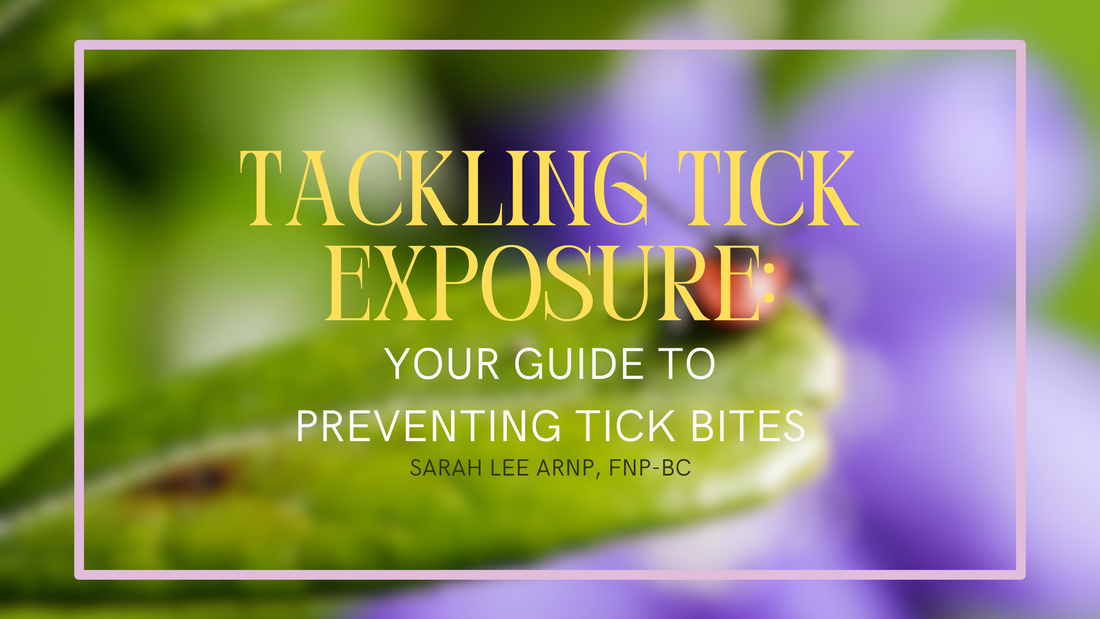Ticks, those tiny yet troublesome creatures, are not just a nuisance but also potential carriers of diseases. We have noticed an “up-tick ;)” in questions about tick bites in the past few weeks due to the high number of ticks right now. With the right knowledge and precautions, you can significantly reduce the likelihood of tick bites and the associated health risks. In this blog, we'll delve into understanding tick exposure and effective prevention strategies.
Understanding Tick Exposure: Ticks thrive in wooded, brushy, and grassy areas. They latch onto animals and humans, feeding on blood to survive and reproduce. While not all ticks carry diseases, some species are notorious for transmitting illnesses such as Lyme disease, Rocky Mountain spotted fever, and babesiosis. Tick bites often occur in regions with dense vegetation or areas where wildlife is abundant. Common hotspots include forests, parks, and even backyard gardens. Ticks are most active during warmer months, typically from spring to fall when people spend more time outdoors. Prevention Strategies: 1. Dress Appropriately When venturing into tick-prone areas, wear hats, long-sleeved shirts, long pants, and closed-toe shoes. Tuck your pants into your socks or boots to create a barrier that makes it harder for ticks to reach your skin. 2. Use Tick Repellents Apply insect repellents to exposed skin and clothing. Geranium oil is a great tick repellent. Permethrin can also be sprayed on clothing, gear, and camping equipment for added protection as a long-lasting repellant. Ticks HATE the smell of geranium oil and permethrin, making it very effective. Remember to follow the instructions on the product label carefully. 3. Stay on Trails Stick to well-traveled paths and avoid brushing against vegetation in tick-infested areas. Ticks often lurk in tall grasses, shrubs, and leaf litter, waiting to hitch a ride on passing hosts. 4. Perform Tick Checks This step is probably one of the most important bite prevention strategies. After spending time outdoors, conduct thorough tick checks on yourself, your children, and your pets. Pay close attention to hidden areas such as the scalp, behind the ears, underarms, groin, and behind the knees. Promptly remove any attached ticks using fine-tipped tweezers, grasping the tick as close to the skin's surface as possible and pulling upward with steady, even pressure. 5. Treat Clothing and Gear Upon returning home, immediately toss outdoor clothing into the dryer on high heat for at least 10 minutes to kill any lingering ticks. This step is crucial even if you didn't notice any ticks on your clothing. Additionally, inspect and wash gear, backpacks, and camping equipment to eliminate any hitchhiking ticks. 6. Create Tick-Safe Zones Make your backyard less inviting to ticks by keeping lawns well-mowed, removing leaf litter, and creating a barrier of wood chips or gravel between wooded areas and recreational spaces. Consider placing playground equipment and seating areas away from dense vegetation. While encountering ticks is often an unavoidable aspect of outdoor activities, taking proactive measures can significantly reduce the risk of tick bites and tick-borne illnesses. By dressing appropriately, using repellents, staying vigilant, and implementing tick-safe practices, you can enjoy the great outdoors with greater peace of mind. Remember, prevention is key when it comes to tick exposure, so arm yourself with knowledge and take the necessary precautions to stay tick-free and healthy!
0 Comments
Your comment will be posted after it is approved.
Leave a Reply. |
Blog Info
Archives
June 2024
Categories
All
|
|
Visit our Locations
IFM | West Des Moines 475 S. 50th St., Suite 600 West Des Moines, IA, 50265 *Temporarily Closed* IFM | Ankeny 207 NE Delaware Ave. Suite 20 Ankeny, IA 50021 |
Office HoursMonday 9:00 a.m. - 5:00 p.m. Tuesday 9:00 a.m. - 5:00 p.m. Wednesday 9:00 a.m. - 5:00 p.m. Thursday 9:00 a.m. - 5:00 p.m. Friday by appointment. Sat & Sun Closed |
© 2024 Integrative Family Medicine of Iowa, PLLC.
All rights reserved.
All rights reserved.



 RSS Feed
RSS Feed

